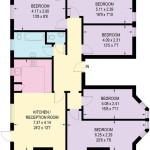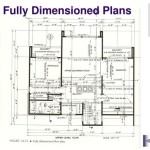40x30 House Plan North Facing With Car Parking: Maximizing Space and Comfort
Designing a house plan for a 40x30 plot of land, especially one facing north, presents both opportunities and challenges. The primary goal is to optimize space utilization while adhering to principles of vastu shastra and modern architectural design. Incorporating dedicated car parking and ensuring adequate ventilation and natural light are key considerations. This article explores the various aspects of designing a 40x30 house plan with a north-facing orientation and car parking, covering different layout options, vastu principles, and design considerations.
A 40x30 plot translates to 1200 square feet, which is a relatively compact area requiring careful planning. The north-facing orientation dictates how sunlight enters the house throughout the day. North-facing homes typically receive less direct sunlight compared to other orientations. Therefore, design strategies should focus on maximizing natural light and ventilation. Car parking is an essential requirement for many households, and integrating it seamlessly into the design is crucial for convenience and aesthetics.
Key Considerations for North-Facing Homes
Designing a north-facing home requires specific attention to certain aspects to compensate for the limited direct sunlight. These aspects include the placement of rooms, the size and location of windows, and the use of light-reflecting materials.
Firstly, orienting living spaces towards the south is important. The south side receives more sunlight, which can naturally warm the living areas during the day. Conversely, rooms that don't require much direct sunlight, such as storage spaces or bathrooms, can be placed on the north side. This design strategy helps in utilizing the available sunlight efficiently.
Secondly, maximize the size of windows on the south and east sides to allow for better natural light penetration. Consider incorporating large windows, skylights, or courtyards to bring in more light. Light-colored walls and reflective surfaces can also help to distribute light throughout the house. The strategic placement of mirrors can enhance this effect further.
Thirdly, ventilation is crucial in north-facing homes to prevent dampness and ensure air circulation. Cross-ventilation can be achieved by placing windows opposite each other to create a natural airflow. Incorporating ventilation shafts or utilizing mechanical ventilation systems can also improve air quality. Plants can be strategically placed to purify the air and create a healthier living environment.
Vastu Shastra Principles for North-Facing Homes
Vastu Shastra, the traditional Indian science of architecture, provides guidelines for designing homes in harmony with nature. Following vastu principles is believed to bring positive energy and prosperity to the occupants. For north-facing homes, certain vastu principles are particularly important.
The north direction is considered auspicious in vastu shastra and is associated with wealth and prosperity. The entrance of the house should ideally be located in the north or east direction. The placement of the main door is critical and should be carefully considered according to vastu guidelines. Avoid placing the main door in the southwest corner of the north side.
The living room should ideally be located in the north or east portion of the house. The master bedroom is best located in the southwest corner, while the kitchen can be placed in the southeast corner. The placement of the toilet is an important aspect to adhere to. The toilet should not be positioned in the northeast corner, but should be placed in the south-west corner.
Keeping the north-east corner of the house clean and clutter-free is essential, as this area is considered the most sacred. This corner should be left open if possible. This allows for positive cosmic energies to flow through the house. Water features can also be placed in the north-east zone, according to vastu principles. Avoid placing heavy furniture or appliances in the north-east corner.
Car Parking Integration in a 40x30 House Plan
Integrating car parking into a 40x30 house plan requires careful consideration of space. Depending on the layout, car parking can be accommodated in various ways, such as an open parking space, a covered carport, or a fully enclosed garage.
An open parking space is the simplest option, requiring a designated area in front of the house for parking a vehicle. This option is suitable for smaller cars and saves space. However, it provides limited protection from the elements and may not be ideal for security purposes.
A covered carport offers partial protection from the sun and rain. It can be integrated into the house design by extending the roof or constructing a separate structure. This option is more aesthetically pleasing than an open parking space and provides better protection for the vehicle.
A fully enclosed garage provides the best protection for the vehicle and offers additional storage space. However, it requires more space and can impact the overall layout of the house. The garage can be integrated into the house design or built as a separate structure connected to the house. It is crucial to ensure that the garage is well-ventilated to prevent the accumulation of harmful gases.
Regardless of the chosen option, the car parking area should be easily accessible from the main road and provide enough maneuvering space. Consider the dimensions of the vehicle when planning the parking space to ensure comfortable parking and departure.
Consider including driveways in the plan that blend well with the overall design of the house. Utilize materials that complement the exterior of the house and ensure proper drainage to prevent water accumulation. Landscaping around the parking area can also enhance the aesthetic appeal of the property.
The location of the parking relative to the main entrance is an important consideration. Ideally, the parking area should not directly obstruct the entrance. Incorporating a small pathway from the parking to the entrance can improve the convenience and aesthetic appeal of the design.
Considering a stilt floor design to incorporate car parking is recommended. This will help to minimize space and also offer a covered parking area.
Layout Options for a 40x30 North-Facing House Plan
Several layout options can be considered for a 40x30 north-facing house plan, depending on the specific needs and preferences of the occupants. These options include 2BHK and 3BHK configurations, with varying room sizes and layouts.
A 2BHK layout typically includes two bedrooms, a living room, a kitchen, and two bathrooms. In a 40x30 plot, a 2BHK layout can be designed with reasonably sized rooms and adequate space for car parking. The master bedroom can be placed in the southwest corner, with the second bedroom in the southeast corner. The living room can be placed in the north or east portion of the house, maximizing natural light. The kitchen can be placed in the southeast corner, adhering to vastu principles.
A 3BHK layout includes three bedrooms, a living room, a kitchen, and two or three bathrooms. Designing a 3BHK layout in a 40x30 plot requires careful space planning to ensure that the rooms are not too small. The master bedroom can be placed in the southwest corner, with the other two bedrooms in the north or east portion of the house. The living room can be placed in the center of the house, with the kitchen in the southeast corner.
In both 2BHK and 3BHK layouts, consider incorporating an open kitchen concept to maximize space and create a more spacious living area. The dining area can be integrated with the living room, creating a cohesive and functional space. Ensure that each bedroom has adequate ventilation and natural light.
Consider Duplex designs, this allows for more space by building a second story. This would free up area to allow for a larger covered car park.
Incorporating a courtyard is another effective way to bring in more natural light and ventilation. A small courtyard can be created in the center of the house, providing a tranquil and refreshing space. The courtyard can also serve as a focal point, adding aesthetic appeal to the house.
Design Considerations for Natural Light and Ventilation
Maximizing natural light and ventilation is crucial for a comfortable and healthy living environment, especially in a north-facing home. Several design strategies can be employed to achieve this goal.
Orient the house to maximize the use of sunlight. The south side receives the most amount of sunlight, and this direction can be used to capture sunlight. Ensure that the windows are sized appropriately to capture sunlight without causing glare.
Use light colors on the interior walls to reflect light. Light colors reflect light more efficiently than dark colors. This can help improve lighting in a room without increasing the amount of artificial lighting that's used. Also, consider using reflective materials to help to increase the amount of ambient lighting in the room.
Skylights can be a valuable addition, allowing natural light to enter from above. They are particularly useful for areas that do not have direct access to windows. Skylights can be installed in the living room, kitchen, or bedrooms to enhance natural lighting.
Cross-ventilation is essential for maintaining air quality and preventing dampness. Placing windows and vents strategically can promote natural airflow and reduce the need for air conditioning. Consider incorporating louvers or adjustable vents to control the amount of airflow.
Landscaping plays a vital role in enhancing natural ventilation and cooling. Planting trees and shrubs around the house can create shade and reduce the temperature inside the house. Choose native species that require minimal maintenance and are well-suited to the local climate.
Consider using energy-efficient windows, doors, and insulation to reduce energy consumption and maintain a comfortable indoor temperature. Double-glazed windows can reduce heat transfer and noise pollution. Proper insulation in the walls and roof can prevent heat loss during winter and heat gain during summer.
The integration of solar panels on the roof is a sustainable solution and can reduce electricity bills. Solar panels can also be used to heat water and power appliances. Consider installing a rainwater harvesting system to conserve water and reduce reliance on municipal water supply.
Creating an air well is an important factor to consider. An air well will allow for greater ventilation throughout the rooms and the interior. This can assist with the heating and cooling of the house. This also helps to maintain high quality of air throughout the rooms.
These considerations demonstrate the complexity of designing an effective 40x30 house plan. These factors can influence the outcome of a home that uses the space effectively.

30x40 House Plan With Car Parking North Facing Plans

North Face 30x40 Feet House Plan With Two Bed Rooms

30x40 North Facing House Plan Houseplansdaily

30 X 40 North Facing Floor Plan Lower Ground Stilt For Car Parking Model House 30x40 Plans Building Designs

30 X 40 North Facing House Plan 2 Storied With Parking And In Ground Floor 2bhk At 1st

North Facing Duplex Plan House Plans Floor

30 X 40 North Facing 2 Bhk With Parking Affordable Home Plan

30x40 North Facing House Plan

30x40 North Facing House Plans As Per Vastu Plan With Car Parking

North Facing Duplex 3bhk 30x40 House Plans








